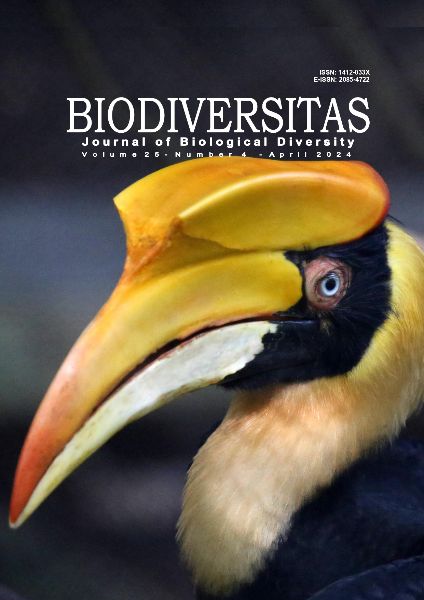Carbon stock, density, and biomass of seagrass in South Bangka, Indonesia
##plugins.themes.bootstrap3.article.main##
Abstract
Abstract. Supratman O, Farhaby AM, Henri, Septiyati MU, Adi W. 2024. Carbon stock, density, and biomass of seagrass in South Bangka, Indonesia. Biodiversitas 25: 1736-1742. As a component of the carbon ecosystem, seagrass meadows play a crucial role in preventing climatic change. The execution of Indonesian programs pertaining to carbon economic value, carbon trading, and other endeavors aimed at attaining the Nationally Determined Contribution (NDC) requires estimated data on seagrass carbon stocks. The present study investigates the seagrass density, vegetation carbon stock, and sediment carbon stock of South Bangka, Indonesia. The investigation is carried out in the following stages: i) data collection on-site, ii) laboratory sample analysis, and iii) data analysis. The accumulation of data on-site utilizes a square transect method, which includes the gathering of sediment, sample biomass, and density information. The carbon composition of sediment and seagrass vegetation is ascertained through laboratory analysis employing the Loss of Ignition (LOI) method. The investigation uncovered eight species of seagrass in South Bangka. Cymondocea rotundata, Enhalus acoroides, Halophila ovalis, Halodule pinifolia, Halodule uninervis, Oceana serrulata, Siringodium isotifolium, and Thalassia Hemprichii are the identified species of seagrass. In South Bangka, the combined carbon stock of seagrass (above and below ground carbon) varies between 0.049±0.057 and 1.323±1.581 Mg C Ha-1. The range of sediment carbon is 110.53±42.07 Mg Corg Ha-1 extrapolated to a depth of 1 m. The results of this study suggest that the seagrass meadows in South Bangka are characterized by a significant species diversity and effectively sequester carbon in the form of biomass and sediment. This supports the National Climate Change Mitigation Program for Blue Carbon Ecosystems, an initiative that seeks to mitigate the adverse effects of climate change by utilizing the carbon sequestration capabilities of mangrove forests, seagrass meadows, and tidal marshes.

